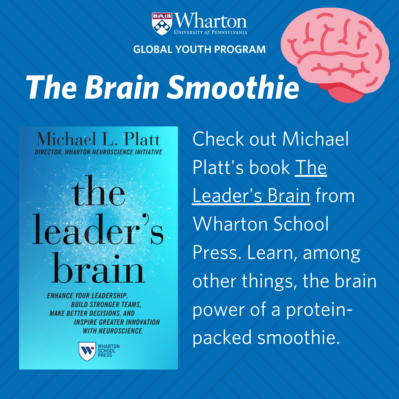The exploration of all the ways that business touches your lives can lead to some intriguing places. Wharton Global Youth has followed economic and entrepreneurial threads inside cities and family businesses, through Hollywood entertainment and Silicon Valley startups, across the blue economy of oceans and ESG investing, to the metaverse and beyond.
One of the most provocative areas of business today asks people to look within for an understanding of some of the key mechanisms underlying decision making, innovation and insight, empathy and human connection – at the nexus of business and brain science.
The Science of Neuroeconomics
The Wharton Neuroscience Initiative at the Wharton School of the University of Pennsylvania, seeks to build better business through brain science, which is to say that business professors are combining the study of the architecture of the brain and how it operates, with their areas of research to understand the business mindset and build better business leaders. Simply stated: neuroscience provides a powerful tool for understanding the reasons that people make the decisions they do.
Michael Platt, founder and director of the Wharton Neuroscience Initiative and a Wharton and Penn professor of marketing, psychology and neuroscience, believes that neuroscience can have a major impact on business in everything from marketing and brand strategy, to leadership. He is a driving force behind the science of neuroeconomics, to help us better understand decisions in all these areas.
Dr. Platt spoke to hundreds of high school students studying with Wharton Global Youth during a Summer High School faculty lecture series on Wharton’s Philadelphia campus.
He helped to define the Wharton Neuroscience Initiative’s work beyond educating students. “We also engage with the community, in particular corporate partners and other partners outside of academia, where we have the opportunity to put our science into practice and collect data to demonstrate the value of using a neuroscience approach to solve challenges in business,” he said.
To illustrate the power of neuroeconomics, Platt shared details of a study in which he and his team applied neuroscience to a specific business marketing challenge: creating more effective brand strategies that lead to stronger customer brand loyalty.
Why is this important? “Customers who have a deeper emotional connection to the brand deliver more value to the company,” Platt noted. “So, this should be the goal of every company, of every brand, to build that kind of social, emotional connection with the brand. To do that, we need to understand how people think and feel about the brand that they own.”
Traditionally, the business world has surveyed people about their connection to brands. Even the field of behavioral economics looks at how people use their money to understand the underlying motivations that lead to their brand decisions. Big data follows the path of customer patterns and activities.
Neuroscience, argued Platt, provides an even more direct window into customers’ brand choices. “Why don’t we just go to the source of all that data, the human brain?” he asked.” That three and a half pounds of meat and fat between your ears…This is the source of everything that you do, every experience that you have, every thought, feeling or decision that you make.”
How Do You Feel About Your Phone?
In the brand-loyalty experiment, Platt examined the activity and pathways of the brain in the context of how people think and feel about their smartphones, particularly high-profile brands Apple and Samsung. “We developed a new approach that we call brand empathy. It hypothesizes that if you have a strong social-emotional bond with a brand, that you will display the sort of patterns of brain activity that you would display to the person you love who is experiencing something good or something bad.”
By analyzing maps of brain activity in Apple and Samsung customers and focusing on parts of the brain involved in empathy, Platt and his team were able to draw conclusions that might help other companies strengthen the emotional connections with their customers, boosting brand loyalty.
A few key findings: Apple customers have strong emotional-social connections to the Apple community and, ultimately, to the company brand. On the other hand, the brain activity of Samsung customers suggests that they choose that brand because they don’t like Apple, not because they really love Samsung. They have very little emotional-social connection to the Samsung brand.
An implication of this neuroscience data, said Platt, is the message it sends to emerging smartphone competitors. “If you are a third phone brand coming into the market, which customers would you try to acquire? Which customers would you spend money trying to target with your advertising? It would be wasted money if you spent it on trying to acquire Apple customers because they’re never going to give it up, right? But Samsung customers are going to be much more willing, because they don’t have that strong personal, social, emotional connection with the brand.”
More importantly, the study reflected that a deep dive into the brain can give researchers a more objective measure of what people are feeling and thinking about brands. “Some brands, like Apple, are better than others, like Samsung, at building social and emotional connections with customers,” noted Platt. “And the key to building these connections is creating a sense of identity and community.”

Companies are exploring other ways to apply neuroeconomics. For example, Lululemon has been using a neuroscience approach to understand how women’s brains respond to different kinds of textiles and fabrics. Neuroscience is increasingly helping to take away the guesswork in business decision-making, suggested Platt.
“I think the biggest area where neuroscience will have an impact is in management and human resources,” he added. “If we can develop a better, more precise understanding of people, of workers and leaders, we can do a better job hiring, a better job onboarding, and a better job of training and development, both at the individual and team level.”
Conversation Starters
Dr. Michael Platt discusses his experiment on smartphone brand loyalty. Where in business do you think neuroscience would be most helpful — seeing into the synapses of the brain? What would you like to feed into the nexus of business and brain science to learn more about how we make decisions?
Dr. Platt and other neuroeconomists believe that a deep dive into the brain can give researchers a more objective measure of what people are feeling and thinking about brands. Maybe a more honest assessment than what someone might respond in a survey. Why is brain science more objective and possibly more reflective of how someone feels? Can you think of any potential challenges with this cognitive approach to building better business?
Do you agree with Dr. Platt’s findings on Apple and Samsung customers? Which are you? Do you have brand loyalty? Why or why not? Do you “belong” to a different brand? Share your customer-centric perspective in the comment section of this article.




